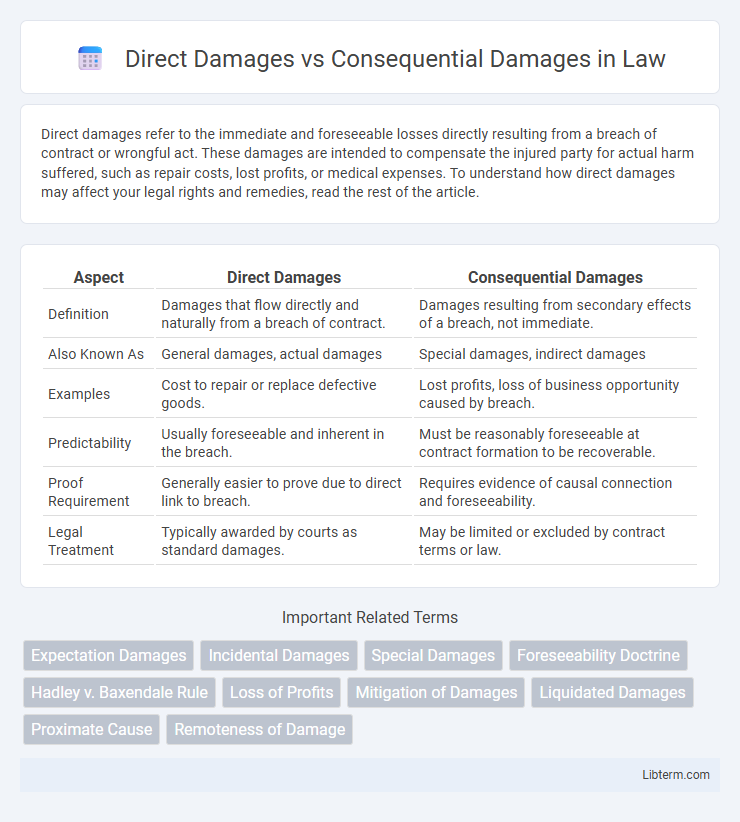Direct damages refer to the immediate and foreseeable losses directly resulting from a breach of contract or wrongful act. These damages are intended to compensate the injured party for actual harm suffered, such as repair costs, lost profits, or medical expenses. To understand how direct damages may affect your legal rights and remedies, read the rest of the article.
Table of Comparison
| Aspect | Direct Damages | Consequential Damages |
|---|---|---|
| Definition | Damages that flow directly and naturally from a breach of contract. | Damages resulting from secondary effects of a breach, not immediate. |
| Also Known As | General damages, actual damages | Special damages, indirect damages |
| Examples | Cost to repair or replace defective goods. | Lost profits, loss of business opportunity caused by breach. |
| Predictability | Usually foreseeable and inherent in the breach. | Must be reasonably foreseeable at contract formation to be recoverable. |
| Proof Requirement | Generally easier to prove due to direct link to breach. | Requires evidence of causal connection and foreseeability. |
| Legal Treatment | Typically awarded by courts as standard damages. | May be limited or excluded by contract terms or law. |
Introduction to Damages in Contract Law
Direct damages in contract law refer to losses that naturally arise from a breach and are typically quantifiable, such as the cost to repair defective goods. Consequential damages, or special damages, encompass indirect losses that result from the breach but are not inherent in the contract itself, like lost profits due to interrupted business operations. Understanding the distinction between direct and consequential damages is essential for determining liability limits and calculating appropriate compensation.
Definition of Direct Damages
Direct damages refer to the immediate and measurable losses resulting from a breach of contract or wrongful act, such as repair costs or replacement fees directly tied to the incident. These damages are quantifiable and flow naturally from the event without needing further proof of additional impact. They are distinct from consequential damages, which involve indirect or secondary losses like lost profits or reputational harm.
Definition of Consequential Damages
Consequential damages, also known as special damages, refer to losses that do not flow directly from a breach of contract but result from the injured party's specific circumstances and foreseeable consequences. These damages encompass indirect effects such as lost profits, additional operational costs, or harm to reputation caused by the breach. Unlike direct damages, which compensate for immediate losses, consequential damages address further financial impacts that are reasonably predictable and caused by the contract violation.
Key Differences Between Direct and Consequential Damages
Direct damages refer to losses that flow immediately and naturally from a breach of contract, representing the actual harm suffered without any intervening causes. Consequential damages, also known as special damages, arise from indirect or secondary effects of the breach, often including lost profits or damages caused by additional consequences beyond the initial harm. The key difference lies in the predictability and causation; direct damages are foreseeable and directly linked to the contract breach, whereas consequential damages require proof of foreseeability and a causal connection to the initial breach.
Legal Criteria for Awarding Direct Damages
Legal criteria for awarding direct damages require proof that the damages resulted immediately and naturally from a breach of contract or wrongful act, emphasizing causation and foreseeability at the time of agreement. Courts assess whether the losses were a definite consequence of the defendant's actions, distinguishing them from indirect or consequential damages that arise from secondary effects. The burden lies on the plaintiff to demonstrate the exact amount and direct link of damages to the breach without reliance on speculative or remote impacts.
Legal Criteria for Awarding Consequential Damages
Legal criteria for awarding consequential damages require the damages to be reasonably foreseeable at the time the contract was formed, directly linked to the breach, and specifically arising from special circumstances communicated between parties. Courts typically mandate clear proof that consequential damages were contemplated or should have been contemplated as a probable result of the breach. Unlike direct damages, which compensate for immediate losses, consequential damages cover indirect losses such as lost profits or additional expenses incurred due to the breach.
Common Examples of Direct Damages
Common examples of direct damages include physical damage to property, loss resulting from breach of contract, and repair or replacement costs directly associated with the defective product or service. These damages reflect immediate and tangible losses incurred due to an incident, such as medical expenses from an injury or costs for fixing a malfunctioning machine. Direct damages are typically easier to quantify and prove compared to consequential damages, which involve indirect or secondary losses.
Common Examples of Consequential Damages
Consequential damages often include lost profits, loss of business opportunity, and damage to reputation resulting from a breach of contract or other wrongful acts. These damages go beyond the immediate impact and cover secondary losses that occur as an indirect consequence of the initial harm. Unlike direct damages, which compensate for straightforward losses like repair costs, consequential damages require proving foreseeability and causal connection to the breach.
Preventing Disputes Over Damages in Contracts
Clearly defining direct damages and consequential damages within contracts minimizes ambiguity and reduces the risk of disputes by specifying which losses are compensable. Including detailed damage limitation clauses and precise language about the scope and calculation of damages helps parties align expectations and legal responsibilities. Regularly reviewing and updating contract terms in response to evolving business practices further prevents conflicts over damage claims.
Conclusion: Choosing the Right Remedies
Selecting the appropriate remedies between direct damages and consequential damages depends on the nature and foreseeability of the loss. Direct damages compensate for the immediate impact of a breach, while consequential damages cover secondary, indirect effects if they were reasonably foreseeable. Businesses must clearly define terms in contracts to ensure proper allocation and recovery of damages aligned with their risk exposure and operational priorities.
Direct Damages Infographic

 libterm.com
libterm.com